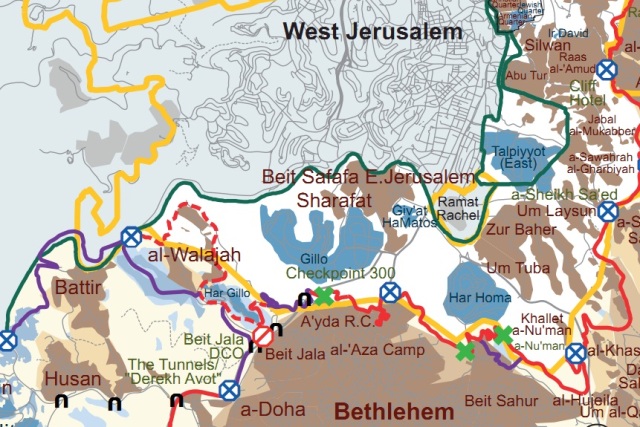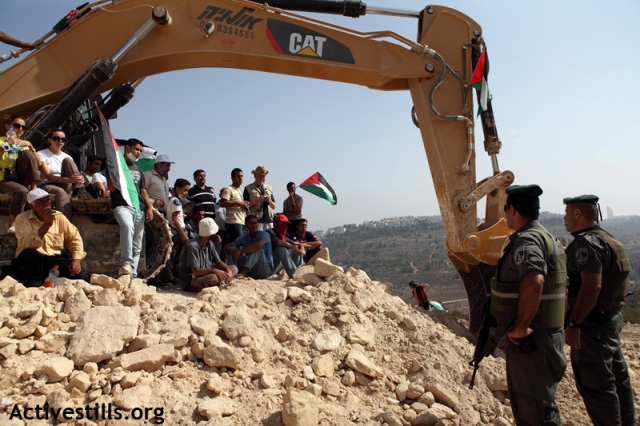There is no place quite like it in the entire West Bank. Residents of the village of Walajah petition the courts, demonstrate, initiate protest theater and music shows – yet still see the wall is expanding and surrounding them from all directions.
Project photography: Oren Ziv / Activestills
The last time I visited Walajah I left only in the late afternoon, around dusk. It was a Friday, and the car was going downhill towards the checkpoint into Jerusalem, a breathtaking view all around, when suddenly I saw tens of Palestinians carrying bags and walking in the opposite direction. At first I thought these might be workers returning home from the city, or a demonstration I had not been informed of, but I soon realized that this was a whole different matter: a little ways before the checkpoint I noticed an area on the hill slopes to my right, where tens of families were picnicking between old ruins and several lively fountains. The people I had seen walking up the road were simply families returning home from a day outdoors.
Seeing the families relaxing, the children jumping into the fountains and the parents looking at Jerusalem stretching on the other side of the valley I remembered how within just a few months time – none of these people would be able to kick back in this little piece of heaven. Walajah is to be encircled by 360 degrees of the separation wall, and the slopes of this hill are to become a leisure park for residents of our capital city. Losing this pleasant place for family picnics might not be the worst result of the village turning into a massive prison, but something in that beautiful spring afternoon turned this appealingly minor effect into something much more horrid.
The court approved, the monastery will be split, the village – encircled
The route of the wall around Walajah is most likely the worst it gets anywhere in the West Bank. Israel does promise that an underground tunnel will connect the village to neighboring Beit Jala and that farmers will still be able to reach their lands – yet the village will still be encircled from all sides by a concrete wall two to eight meters high, and villagers will lose free access to their land, as well as any chance for expanding and the unique view their homes now offer. The picnic grounds will serve people of a different nature.
The original village of Walajah, dating back to at least the 16th century, once stood several miles to the north-west of its current location. In 1949 its residents fled the Israeli army, crossed the Emek Refa’im valley, and rebuilt their village on their own agricultural lands – then in Jordan. Their original village now stands in ruin under a KKL (JNF) forest and Kibutz Aminadav. In 1967 part of the (new) village was annexed to Jerusalem, part of its lands served to build the settlements of Gilo and Har Gilo, yet the villagers were not given Israeli IDs (as was the norm in parts of Jerusalem that were annexed in full).
Only in 2006-7 did Israeli authorities finalize the details and approve the route of the wall in Walajah the way we now know it, and ever since 2007 the village has been locked in a court struggle against it. Other than the encircling the entire village, the route also cuts a monastery in two, separating the monks and the nuns, and leaves one house on the wrong side of the wall – requiring a special fence that will encircle that house, and another underground tunnel to connect it to the village. The High Court at first stopped construction of the wall, but in 2011 allowed the state to proceed with construction even though a final ruling on the route has not been given. Since then bulldozers have returned to the village, and residents are trying to fight the wall, the park, and a new settlement planned on its lands.
In between court sessions a small group of villagers is trying to lead a popular struggle against the wall. In several instances Israeli and international activists helped in stopping construction for awhile until arrested. However, on the whole, the village was unable to stick to regular demonstrations like those in Jayous, Budrus, Bil’in and Ma’asara.
On occasion the villagers have a music or theater show on the route of the wall, or organize some other form of creative and artistic protest. Just last months members of the Jenin Freedom Theater preformed with a play-back acting technique outside the lone house outside the wall. Police tried to prevent supporters from coming, but most were able to break through the blockade and reach the show. It was after this event that I saw the picnicking families.
‘A microcosm of Palestine’
When I first came to a demonstration in Walajah in 2007 I was extremely happy to find out that one of the local leaders of the struggle was Sheerin Al-Araj. Al-Araj was a guide of mine in the Israeli-Palestinian-Jordanian “Nir” summer school I attended in the late nineties, and she has since been working as a freelance human rights activist, and was amongst other things sent by the UN on humanitarian missions to Sudan, Lebanon, Ethiopia and Iraq. While resting at home, she tries to defend her own human rights, and those of her neighbors.
“The truth is we’re not that good with demonstrations around here,” Al-Araj confesses, laughing. “But we do other things. We see that we’ll be soon be surrounded from all sides, and so we start helping people, mainly women, prepare for life under the new restrictions we’ll be facing once the wall is complete. Meanwhile we also turn to journalists and diplomats, we had representatives of the EU and the US at our court sessions, but I don’t think any of this will stop the construction now, and we will probably lose our lands.
“It’s because it’s so extreme here that I feel this is like a microcosm of Palestine. Nobody is holding Israel accountable for its actions, it has the full support of the superpowers, and as long as this is the case it will go on with its crimes. However, I’m sure that this will change one day. It might take 10 or 15 years, but things will change, and when they do Israeli will most likely not only have to deal with Palestinians but with the entire Arab world. I really hope Israelis understand this now and find a solution that won’t lead us to killing each other – but I don’t see them trying to change that destiny.”
As Al-Araj speaks I see the parts of the wall already in place, the route where the rest is going to be built, and in the background – Jerusalem. It takes five minutes by car, including going through the checkpoint, to get to Jerusalem’s main football stadium (“Teddy”). I try to imagine how life in the village will look like with only one underground connection to the rest of the world, what would happen if the tunnel collapses or get flooded, or simply how it is possible to live with a wall all around you. The question reminds me of my days in prison, and how sometimes my only consolation would be to look for the last piece of open nature a prisoner has left for him. I look up to the sky and see them turning dark, the clouds in burning sunset red. Al-Araj’s prophecy of rage seems desperately realistic.
Previous chapters in this series:
Part 1: The great Israeli project
Part 2: Wall and Peace
Part 3: An acre here and an acre there
Part 4: Trapped on the wrong side
Part 5: A new way of resistance
Part 6: What has the struggle achieved?
Next:







